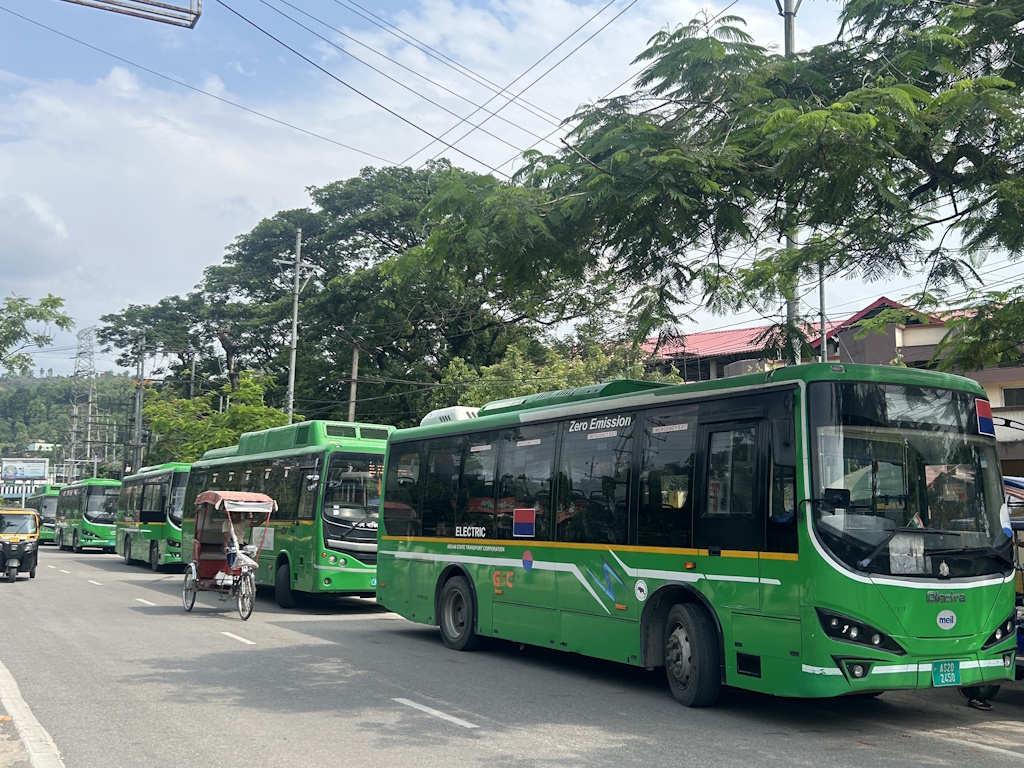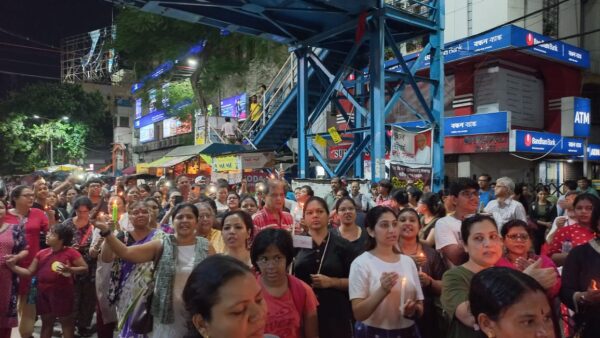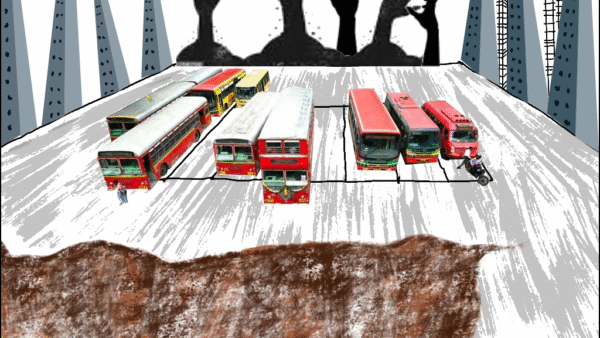In Guwahati, as in other rapidly growing cities, public bus transport remains the only affordable and accessible mode of mobility for thousands of daily commuters- students, workers, women, and the elderly. Approximately 1,00,000 commuters use city buses daily with each bus making 4–5 trips a day, according to the Assam State Transport Corporation (ASTC).[1] Yet, the condition of the city’s bus system raises critical questions about planning, infrastructure, and equity. As Guwahati grapples with soaring temperatures, relentless construction, and recurring floods, the everyday commute becomes more challenging.
From the early morning queues at Khanapara to the congested roads of Paltan Bazar, a bus ride with street-level observations and conversations gives a portrait of a public system that has been stretched thin, marked by class divide, gendered vulnerabilities, but also the resilience of its users. Rows of buses, some government-run and others privately operated, line up at Khanapara, especially the ones operating in that route. Drivers and conductors prepare for the trip, hurriedly grabbing a bite from the makeshift stalls on the pavement, refilling their water bottles, laughing with the camaraderie of men who work long hours together.
The ASTC was formally established in 1970 but had operated two buses between Guwahati and Nagaon since 1948. Guwahati’s bus system began in 1949 from Pandughat to Uzanbazar Jahajghat, and gradually expanded to areas such as Panbazar and Fancy Bazar, embedding itself into the rhythm of an expanding city.[2] The ASTC now operates over 1,100 buses; an additional 1,200 private buses run in partnership with ASTC across Assam. The ASTC also maintains 135 bus stations and three inter-state bus terminals across the state and it rolled out 200 electric buses in January 2024.[3]
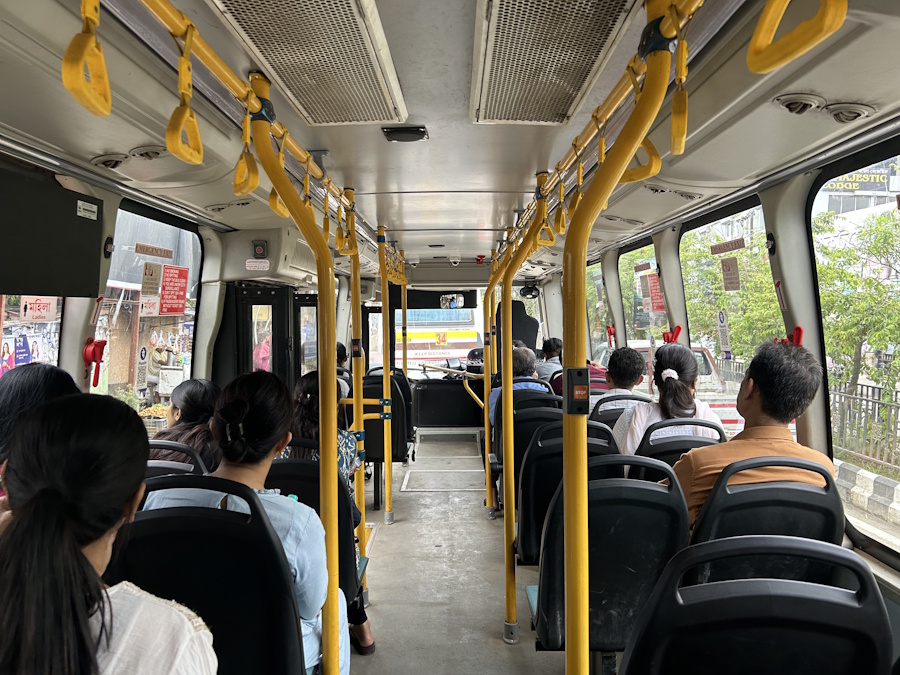
The AC bus experience
Boarding one of the new AC green buses is a visibly different and more comfortable experience compared to the old buses, especially when the temperatures soar. Cool air circulates inside but the bus is semi-vacant. A middle-aged woman says to a fellow passenger, “These green buses are such a relief in the heat. I don’t mind waiting five extra minutes for this.” The bus moves through Guwahati’s busy roads with the driver making “unscheduled” stops wherever someone waves down the bus — at traffic intersections, in under-construction lanes, near flyover ramps.
But commuters get restive. “Oye, why have you stopped for such a long time? I’m getting late for work,” yells a man. The GPlus report[4] pointed out that many commuters have complained about long wait times at bus stops and drivers making unscheduled halts or extending wait times has been annoying. “It is very difficult to travel by bus if we get late for work,” said a daily commuter from Rupnagar to Panikheti.
In a green bus, a conductor explained that they are under pressure to meet the daily revenue targets of Rs 6,500 which forces them to wait longer for commuters. These delays, dictated by financial decisions, disrupt the city’s already stretched traffic, leaving commuters frustrated and late.[5] So, though the AC green buses are comfortable and less crowded, they take twice the time to reach any destination, people scramble to get on or off in narrow lanes and at busy junctions, the elderly and children find it difficult, and there is commotion all around.
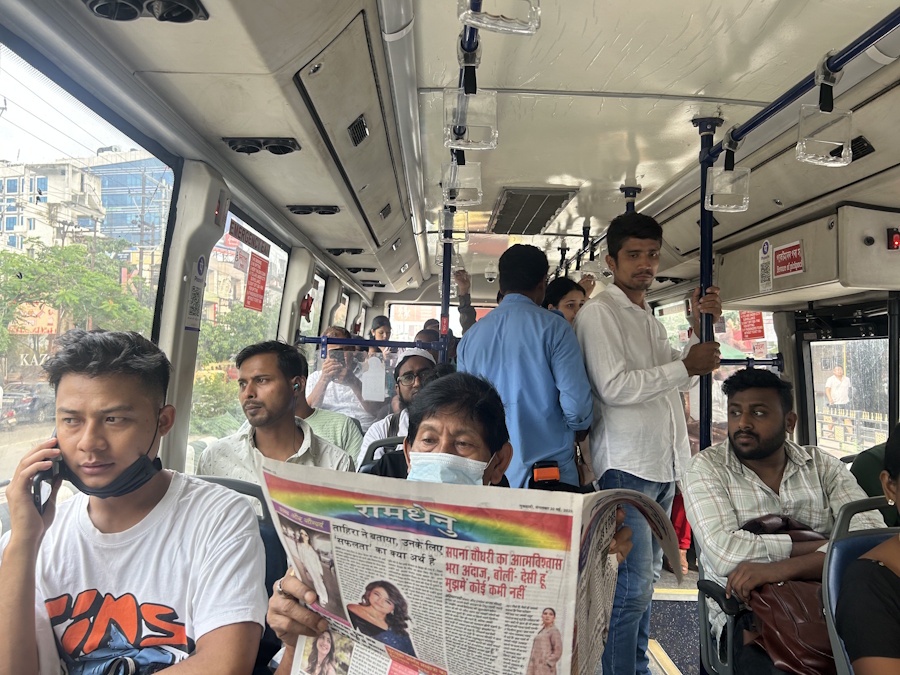
The approximately 40-minute ride from Khanapara, a key transit hub at the city’s edge to Bhangagarh, a busy medical and commercial zone, cost Rs 20 compared to intermediate transport like taxis which would be Rs 150-200. The minimum fare in AC buses is Rs 15 and non-AC is Rs 10, making buses the most affordable mode. For old-timers like Monalisha Saikia, 50, buses hold layered memories. She recalled her college days saying how she “used to take the city bus everywhere — for college, errands, even family visits and fares were just a rupee.” However, her preferences changed with time and she prefers cabs now. “The buses have become too crowded and chaotic.”
The non-AC bus
Saikia’s reflections are a window into how Guwahati’s transport system has evolved over the decades. Although the bus remains affordable and, sometimes convenient, it is much slower and more chaotic than other modes of transport. Before the rapid expansion in the past few years, Guwahati was a quieter city with fewer vehicles and without major traffic jams. As the city changed, commuting did too.
The non-AC private bus is a world apart from the AC green buses. Every inch of space in it was claimed — men and women, young and old, squeezed into standing and sitting spaces. The air inside was heavy with sweat and fatigue. A group of tired students from Handique Girls’ College stood in the centre of the aisle, their faces showing the strain of a long day in the summer heat. The conductor, also tired from hours of shouting, somehow managed “Ahok ahok, Khali gari!” (Come, come, empty vehicle!) — a phrase that has become a meme among Guwahati’s commuters. Of course, no seat or standing space was empty.
Animesh Deka, 22, a daily commuter, said, “Often, the conductors don’t give tickets unless you ask. There’s no regulation. Sometimes, the bus doesn’t even reach its last stop and we are left stranded.” But the non-AC bus is the lifeline for many who do not have the time to wait for the more comfortable AC bus and also cannot afford the higher fares of autorickshaws.
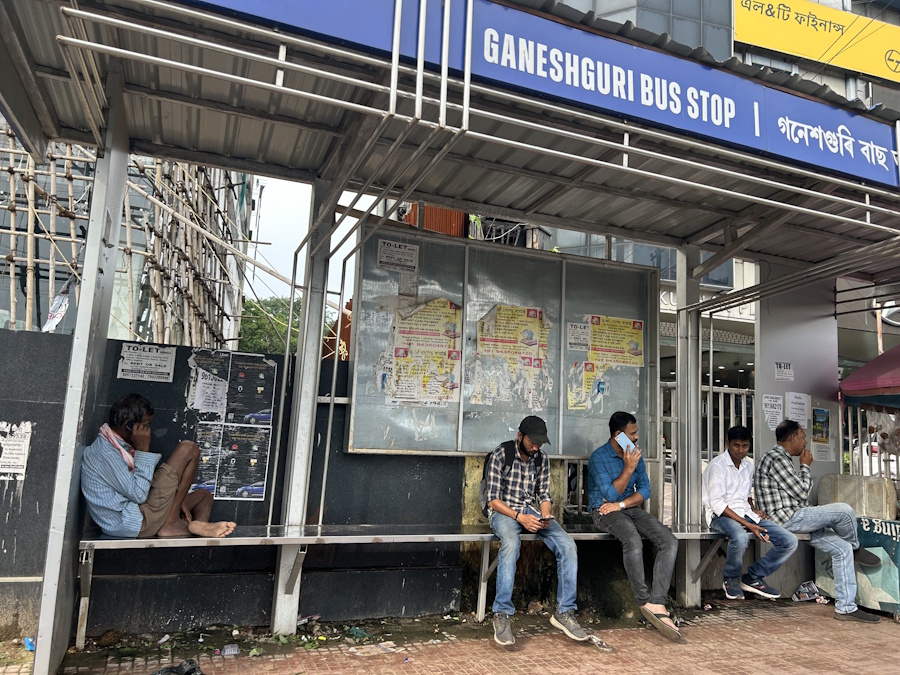
The working class and the metro
Although Guwahati does not have a metro network, people strongly favour it as a long-term solution to the city’s transport issues. A GPlus poll in 2023 showed that over 66 percent of residents were dissatisfied with the public transport system with irregular bus schedules, long wait time, and overcrowding as their reasons, and saw the metro as a potential game changer with faster and safer travel. However, the metro would be more expensive and for a large section of Guwahati’s working class, affordability is paramount. Buses, flawed as they are, remain the most cost-effective.[6]
Guwahati has seen the rise of other modes. Cab services like Rapido, Ola, and Uber underscore the shortcomings of the bus system. Rapido reported over 9,000 daily rides five years ago. This year, Uber announced a Rs 120-crore investment in Assam. However, these options remain out of reach for many working-class residents. This modal shift risks deepening urban inequalities too.[7]
Simple changes in the bus system would make a huge difference. For example, all bus routes do not complete their run. Basistha-bound buses often turn around prematurely forcing passengers to scramble for rickshaws. This is not only a detour but also risky. A young woman returning late from coaching classes said, “It’s an extra financial burden but the fear of waiting late at night for another vehicle is worse.” The shortcuts that the buses take are disproportionately affecting women, students, and the working poor.
Another issue that could easily be addressed is the crush inside buses which is particularly difficult for women and girls. Barnil Medhi, a student, said, “It is unbearable and unsafe for women. The overcrowding and heat are bad enough but the close physical contact is extremely uncomfortable.” Despite this, women form a significant portion of the city’s bus users, braving the lack of safety and comfort.
Jharana Bharali, a professional and student, highlighted how deeply embedded these issues are in women’s experience of public transport. She has narrowly escaped accidents because drivers recklessly try to overtake each other. “Many don’t care about our safety,” she says, “but it’s also how conductors and drivers communicate with loud and aggressive cuss words. It’s not a language you want to hear in a public space.” But, like many others, she chooses silence over confrontation, fearing retaliation.

For women, crowded buses also mean inappropriate touches. Stern looks may be a response but not a guarantee of safety. “We’re educated only in name,” Jharana again remarked sharply, “not in the true sense, not civilised.” To address gender issues and provide free, safe rides to women and senior citizens, Guwahati introduced pink buses under the Bhraman Sarathi scheme in 2021. However, due to poor frequency and mismanagement, only a few were operational a year later.[8]
As Jharana argues, it is not about free rides but safe and designated spaces. “At night or early morning, when buses are nearly empty I feel scared to board or even wait at bus stops. The bike taxis aren’t safe either.” Construction zones make roads hazardous for all modes of travel but her words underscore the need that women have in Guwahati: safe, reliable, and inclusive public transport that does not turn their vulnerability into profit for taxis and rickshaws.
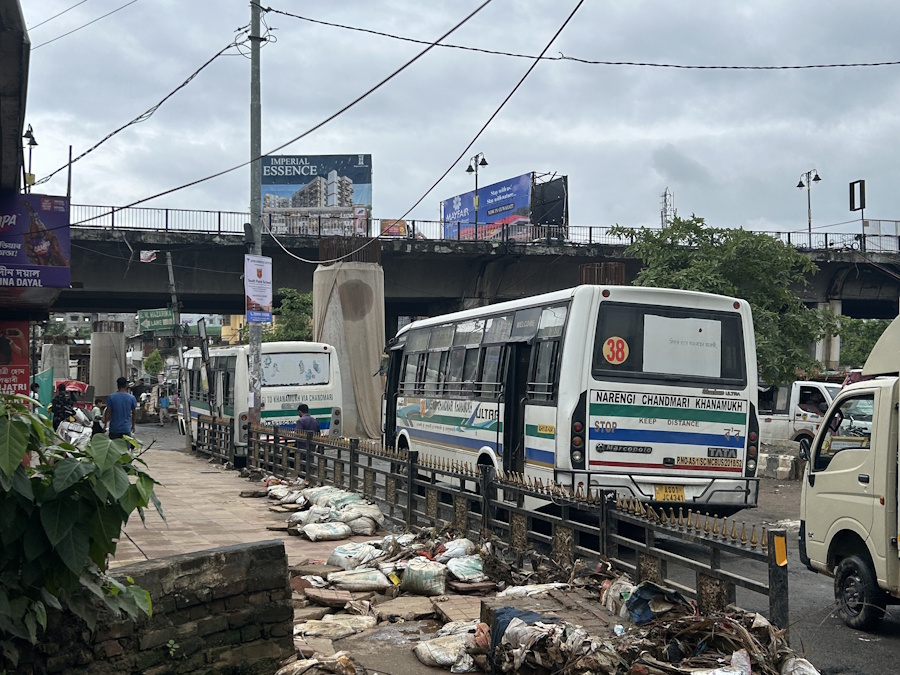
Streamline the roads
Guwahati’s roads are a battlefield. Endless construction projects—flyovers, Smart City drainage lines, footpath relaying, riverfront beautification all choke the city’s carriageways. The monsoon makes this worse with waterlogging. A stalled bus on a dug-up section of a road can delay commuters by more than half an hour. “All of Guwahati is under construction. But for whom?” wondered a bus commuter.
These projects have exacerbated, not alleviated, people’s daily hardships on roads. Bus drivers idling away, waiting for commuters to fill the vehicles, adds to this chaos and loss of time. It also worsens the load on the traffic police, especially at busy junctions like Bharalumukh and Paltan Bazar.
Guwahati’s bus transport faces a crisis of capacity and reliability. The number of ASTC buses in the city is estimated at 800 but chronic maintenance issues means that, at most times, about 320 buses have been off the roads.[9] Between 2021 and 2024, private vehicle registration surged a whopping 37 percent – from 82,767 to over 1,13,000.[10] This growing reliance on private vehicles has drawn commuters away from buses..[11]
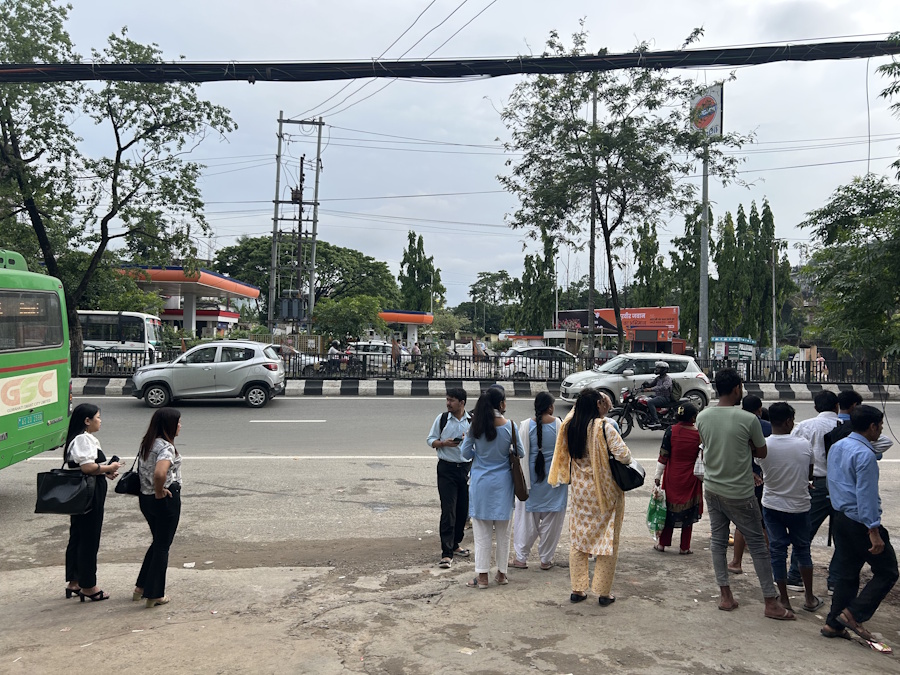
Although Guwahati has designated bus stops, the system of operation means that commuters and drivers often ignore them and stop wherever they want to. Many bus commuters wait in empty spaces on busy roads, at undesignated bus stops, showing how chaotic the bus system is. It all stems from commuters who want to board and alight close to their destinations and drivers who are happy to make these stops to maximise their earnings. Addressing this one issue could streamline Guwahati’s bus system.
Buses in Guwahati, like in many Indian cities, are not merely about mobility. They are the city’s lifeline and the only means of commuting for many. But they are also sites of frustration and anxiety, especially for women. Buses also reflect something deeper — the city’s inequality in who can afford to wait, who can travel more comfortably in AC buses, who can spend more on rickshaws and cabs. Of course, the working class and the poor have no choice and bear the brunt of an unplanned or inefficient bus system.
The bus system in Guwahati, as in other cities, is a metaphor for how the city is and how life is lived unequally.
Sugandhi Prapti, based in Guwahati, is a Sociology graduate from Lady Shri Ram College for Women with a minor in Journalism, currently interning with Question of Cities through the Indian Institute for Human Settlements. As an Urban Fellow at IIHS, her research interest lies on urban vulnerability, marginalized communities, and ecological challenges. With a strong passion for ethnographic research,visual media and storytelling, she aspires to explore the intersections of urban development, social inequality and environmental issues, particularly in the context of Northeast India.
Photos: Sugandhi Prapti

